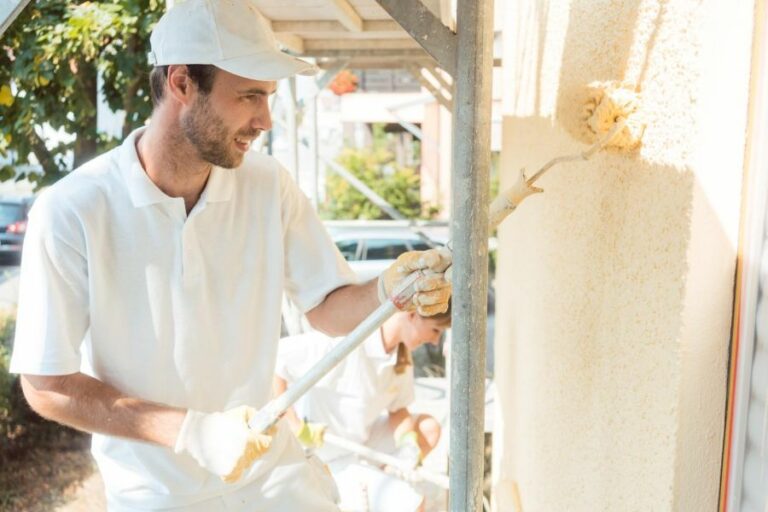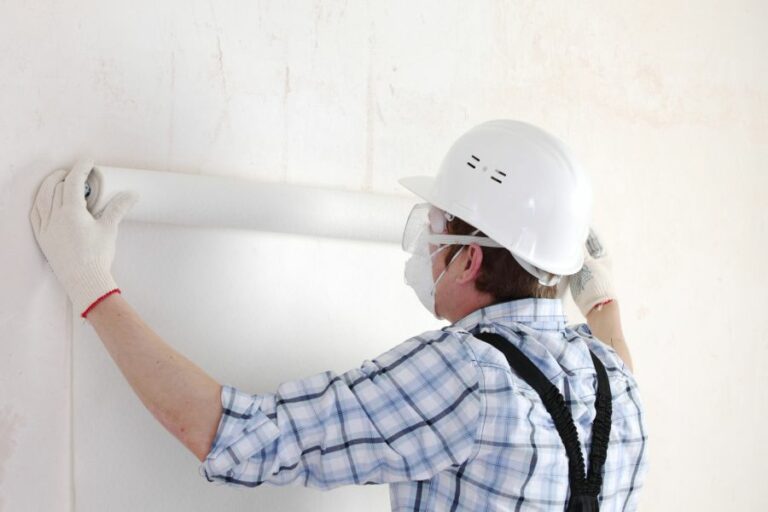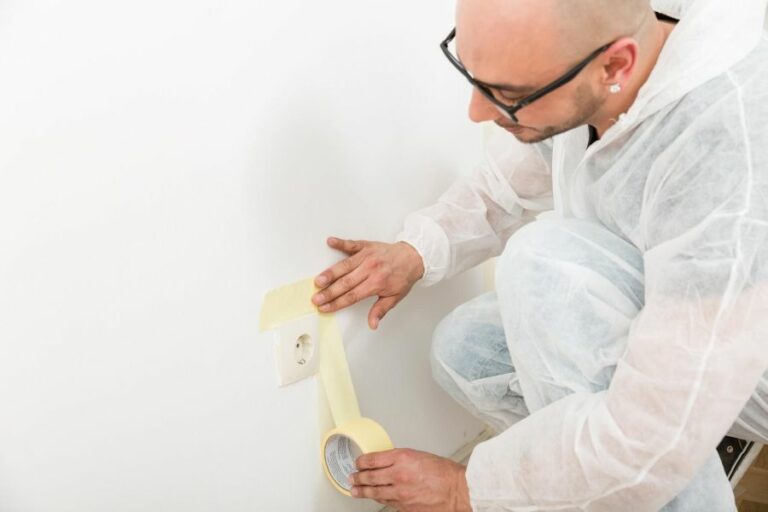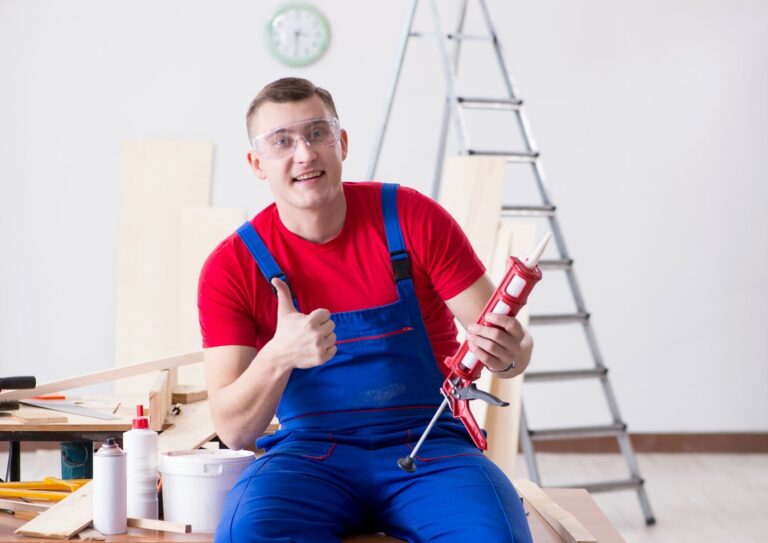Proper Surface Preparation For Painting Different Materials
When it comes to achieving a flawless, long-lasting paint job on various materials such as wood, metal, and masonry, proper surface preparation is the key. Fear not; we’ve got you covered! Our comprehensive guide will walk you through each step of the process, tailored to the specific material you’re working with.
Proper surface preparation for painting different materials like wood, metal, and masonry:
Proper surface preparation is vital for a long-lasting, professional paint job on wood, metal, and masonry materials. This involves cleaning the surface, repairing damages, and using a material-appropriate primer to ensure paint adhesion and longevity. Following specified techniques for each material type will yield successful results.

Discover the secrets to achieving flawless paintwork on various surfaces, such as wood, metal, and masonry. Learn the right techniques to prepare each material for a long-lasting, professional finish. Don’t miss the opportunity to boost your painting skills. Read on for more insights!
Contents
- 1 Effective Surface Prep Techniques for Wood, Metal, & Masonry Painting
- 2 The Ideal Sequence for Surface Preparation Prior to Painting
- 3 Understanding Pre-Painting Surface Preparation Essentials
- 4 Key Steps in Pre-Painting Surface Prep for Metal Surfaces
- 5 Exploring Diverse Methods of Surface Preparation Techniques
Effective Surface Prep Techniques for Wood, Metal, & Masonry Painting
• Introduction
Proper surface preparation is crucial for achieving a long-lasting and professional-looking paint job. Different materials like wood, metal, and masonry require unique approaches to ensure the paint adheres correctly and lasts a long time.
• Preparing Wooden Surfaces
Wood is a popular material for both indoor and outdoor surfaces. Before painting, it’s essential to properly prepare the surface to achieve the desired finish and ensure the paint’s longevity. Here are some steps to follow:
– Clean the Surface
Start by cleaning the wooden surface to get rid of dirt, dust, and grime. Use a mild detergent combined with water and a soft brush or cloth. Avoid using harsh chemicals or abrasive materials, as they might damage the wood.
– Repair Damage
Wooden surfaces can suffer from various damages, such as cracks or rot. Fill any holes or cracks with wood filler and allow it to dry. If necessary, replace any rotted wood sections to ensure a stable and healthier base for your paint.
– Sanding
Sanding is essential for achieving a smooth surface and proper paint adhesion. Start with coarse sandpaper (80-100 grit) and work your way up to fine sandpaper (220 grit). Always sand in the direction of the wood grain to avoid scratches. Remove any sanding dust with a tack cloth or vacuum cleaner.
– Priming
Applying a primer to the wood will help seal the surface and provide a smooth foundation for the paint. Choose a primer based on your wood type and the paint you’ll be using. Allow the primer to dry completely before applying the paint.
• Preparing Metal Surfaces
Metal surfaces, such as railings and furniture, often require painting to improve their appearance or protect against rust and corrosion. Here’s how to prepare metal surfaces for painting:
– Remove Rust and Old Paint
Use a wire brush or sandpaper to remove any rust, old paint or loose particles. This step is critical to ensure proper paint adhesion and a smooth finish. Pay close attention to any crevices or hard-to-reach areas.
– Clean the Surface
Just like wood surfaces, it’s essential to clean metal surfaces before painting. Use a degreaser or soapy water with a cloth or sponge to get rid of any dirt and grease. After cleaning, let the surface dry completely.
– Apply a Rust-Inhibitor
To prevent rust and corrosion, apply a rust-inhibiting primer to the metal surface. This type of primer will ensure long-lasting paint adhesion and protection against the elements, particularly for outdoor metal objects.
– Priming
Using a metal-specific primer will provide a smooth foundation and improved paint adherence. The primer choice will depend on the type of paint you plan to use and your metal surface’s specific needs.
• Preparing Masonry Surfaces
Masonry surfaces, such as brick, stucco, or concrete, are also popular materials, both indoors and outdoors. Here’s how to prepare masonry surfaces for painting:
– Check for Damages
Inspect the masonry surface for any damages, such as cracks or holes, and repair them with the appropriate filler or mortar. For more severe damages, it’s recommended to consult a professional.
– Clean the Surface
Masonry surfaces often accumulate dirt and mildew, especially in outdoor and damp environments. Use a power washer or a brush combined with a masonry cleaner to eliminate these substances. Allow the surface to dry for at least 24 hours before proceeding.
– Seal the Surface
Masonry surfaces are often porous, which can lead to moisture infiltration and paint peeling. Applying a high-quality masonry sealer can help protect the surface and ensure proper paint adhesion. Follow the manufacturer’s instructions for drying time.
– Priming
A masonry-specific primer is essential for achieving the best paint adherence and durability. These primers are designed to handle the unique characteristics of masonry surfaces, so selecting the right primer is crucial.
• Conclusion
Regardless of the material, proper surface preparation is key to achieving a professional and long-lasting paint job. Following the above guidelines for wood, metal, and masonry surfaces will help ensure your paint project’s success.
For additional resources and guidance, visit the Painting and Decorating Contractors of America (PDCA) website to learn more about industry standards and best practices.
The Ideal Sequence for Surface Preparation Prior to Painting
A well-prepared surface is key to achieving a professional-looking paint job. As an experienced painter, I’ve learned that there are specific steps to take when preparing a surface for painting. In this article, we will discuss these steps in the correct order to help ensure a successful paint job.
• Step 1: Assess the Current Condition of the Surface
The first step is to carefully evaluate the surface you plan to paint. Check for issues such as peeling paint, loose debris, holes, cracks, mold, or mildew. Each type of surface problem will require a different approach to ensure proper preparation.
For walls with paint peeling or flaking: When encountering this issue on walls, use a scraper or putty knife to remove any loose or peeling paint gently. For larger areas or stubborn paint, you may require a heat gun or paint remover.
For walls with loose debris: Dust and dirt must be removed before painting. Use a soft brush or vacuum cleaner to collect any debris from the surface.
For walls with holes or cracks: Before painting, make sure to fill in any holes or cracks with a suitable filler. Different types of fillers are available, including wall putty, joint compound, or patching plaster.
For walls with mold or mildew: If you find mold or mildew on your walls, clean the area with a solution containing bleach and water (1 part bleach to 3 parts water) or white vinegar. Allow the surface to dry, and apply a mold-resistant primer before painting.
• Step 2: Sanding and Cleaning the Surface
After dealing with any surface issues, sanding is the next crucial step. Sanding creates a smooth, even surface that helps paint adhere properly. Use a sanding block or electric sander with fine-grit sandpaper (120-grit to 150-grit).
Once you have sanded the entire surface, be sure to clean it thoroughly. Use a damp cloth to wipe away any dust or debris left behind from sanding.
Remember to change the cloth frequently to ensure a clean surface. Cleaning the surface also helps to remove any remaining grease or dirt that may have been missed during the initial assessment of the surface.
• Step 3: Priming the Surface
Priming is essential for proper paint adhesion and achieving a uniform appearance. Primers also help block stains and provide a barrier against problems such as mold or mildew.
Choose the appropriate primer for your surface oil-based primers work best for wood surfaces, while latex-based primers are more effective on drywall, plaster, and concrete.
Apply the primer evenly using a brush or roller. Allow the primer to dry according to the manufacturer’s instructions, which generally takes anywhere from one to four hours.
In some cases, you may need to apply more than one coat of primer, especially on porous surfaces or when dealing with mold or mildew issues.
• Step 4: Taping and Protecting the Area
After the primer has completely dried, it’s time to tape off any areas you don’t want to paint. Use painter’s tape to cover baseboards, outlets, windows, trim, and any other areas that need protection. You can also use plastic sheeting or drop cloths to cover the floor and furniture.
Taping and preparing the area helps to achieve clean, professional lines and protects surfaces not intended for painting.
• Step 5: Applying the Paint
Once the surface is prepared and protected, it’s time to apply your chosen paint. Use a quality brush or roller for an even application, and apply the paint in accordance with the manufacturer’s directions.
Generally, you will need to apply at least two coats of paint, allowing sufficient time for drying between coats as specified by the paint manufacturer.
After all coats of paint are dry, carefully remove the painter’s tape and protective coverings to reveal the final result. Proper surface preparation is key to the success of your paint job, and following these steps will help ensure a professional, long-lasting finish.
For further information, check the U.S. Environmental Protection Agency’s guidelines on safe painting practices and how to protect yourself and your surroundings during the painting process.
Understanding Pre-Painting Surface Preparation Essentials
When tackling any painting project, one of the key steps to ensure the successful application and longevity of the paint is thorough surface preparation. Whether you are painting a wall, a piece of furniture, or structural steel, properly preparing the surface is vital for achieving high-quality results.
• Understanding Surface Preparation
Surface preparation involves a series of processes targeted at removing contaminants, smoothing rough areas, and creating a suitable surface profile for the paint to adhere to effectively. This process can vary depending on the type of surface and the specific requirements of the painting system being used.
– Types of Surface Contaminants
Before beginning surface preparation, it is essential to identify and remove any contaminants present on the surface. These contaminants can negatively impact the adhesion of the paint, potentially leading to premature paint failure. Common contaminants include:
- Dirt and dust
- Grease and oil
- Rust and corrosion
- Previous paint layers
- Mold and mildew
– Types of Surface Preparation Processes
There are various methods and tools available for surface preparation, each with its benefits and limitations. Some common techniques include:
- Cleaning: This process involves using a combination of cleaning agents and water to remove dirt, grease, oil, and other contaminants from the surface.
- Scraping: A scraper is used to remove loose or peeling paint, as well as any rust or corrosion on the surface.
- Sanding: Sandpaper or a sanding machine is used to smooth rough surfaces, promote adhesion, and create a suitable surface profile for the paint.
- Pressure washing: This technique uses pressurized water to clean and remove contaminants from large surface areas.
- Abrasive blasting: This method, such as sandblasting or shot blasting, effectively removes stubborn contaminants and creates an ideal surface profile for paint adhesion.
– Recommended Surface Preparation Process Based on Substrate
Different surfaces require distinct approaches to preparation. Here are some recommendations based on the type of substrate:
- Wood: Begin by removing any loose, peeling, or flaking paint. Then, sand the surface using coarse sandpaper, followed by finer grit sandpaper to create a smooth finish. Ensure the surface is clean by wiping it with a damp cloth and allowing it to dry before painting.
- Concrete: Repair any cracks or defects in the concrete, followed by a thorough cleaning to remove dirt, dust, and any efflorescence (crystalline deposits). Concrete should then be allowed to dry for at least 28 days before applying paint.
- Metal: Begin by removing any loose rust or corrosion using a scraper, wire brush, or abrasive blast media. Clean the surface to remove any oil, grease, or other contaminants, and ensure it is dry before applying paint. In some cases, applying a primer may be necessary for optimal adhesion and corrosion protection.
- Drywall: Repair any visible defects such as dents, cracks, or nail holes with a joint compound. Sand the surface smooth, wipe away dust, and proceed with painting.
• Importance of Surface Profile
Creating an appropriate surface profile is crucial for the paint to adhere effectively. Surface profile refers to the micro-roughness or texture of the surface, which enables mechanical adhesion of the paint.
A surface that is too smooth may not allow the paint to grip, whereas an overly rough surface may yield uneven paint coverage and a poor finish.
– Achieving the Right Surface Profile
Using proper techniques during the surface preparation process will help create an ideal surface profile. For example:
- Sanding wood creates an even, smooth surface for the paint to adhere
- Abrasive blasting on metal surfaces generates a textured profile that promotes adhesion
- Applying a primer to concrete surfaces can help fill small voids and create an even surface for paint application
The specific surface profile requirements will vary depending on the recommended guidelines of the painting system you are using. Always consult the paint manufacturer’s instructions for recommended surface preparation procedures.
• Final Thoughts on Surface Preparation
In conclusion, surface preparation is a critical step in the painting process and should not be overlooked. Proper surface preparation promotes paint adhesion, reduces the risk of paint failure, and ultimately contributes to a high-quality, long-lasting finish.
By understanding the types of contaminants, utilizing appropriate preparation techniques, and creating an ideal surface profile, you can ensure a successful painting project.
For further information on surface preparation and painting, refer to reliable sources such as The United States Environmental Protection Agency.
Key Steps in Pre-Painting Surface Prep for Metal Surfaces
Proper surface preparation is crucial for achieving a high-quality, long-lasting paint job on metal surfaces.
• Importance of Surface Preparation
Surface preparation plays a critical role in the performance and longevity of the paint system applied to metal surfaces. The key objectives of surface preparation are:
- To remove all contaminants, including oils, grease, dust, and dirt, from the metal surface.
- To create a suitable surface profile that promotes maximum adhesion between the applied paint and the metal substrate.
With proper surface preparation, you can significantly enhance the appearance and durability of the painted metal structure.
• Step 1: Cleaning the Surface
– Removing Oil, Grease, and Other Contaminants
The first step in surface preparation is to clean the metal surface thoroughly. To remove oils, grease, and other contaminants from the surface, a solvent or detergent cleaner may be used. Some of the recommended cleaners include:
- Mineral spirits
- Acetone
- Denatured alcohol
These solvents can be applied using a lint-free rag or brush, gently rubbing the surface in a circular motion until all contaminants are removed.
– Removing Dust and Debris
Once all oil and grease have been removed, wipe the surface with a clean, dry rag or use an air compressor to blow off any remaining dust and debris. Following these cleaning steps helps to ensure strong adhesion between the metal surface and the paint.
• Step 2: Removing Surface Imperfections
– Sanding
Sanding is essential for creating a smooth surface that allows for even coverage and proper adhesion of the paint. It is important to select the appropriate sandpaper grit, depending on the type and condition of the metal surface.
- For heavily rusted or pitted surfaces, use coarse sandpaper (80-100 grit).
- For lightly rusted or damaged surfaces, use medium sandpaper (180-240 grit).
- For surfaces with minimal rust or damage, use fine sandpaper (360-600 grit).
Sanding should be done by hand or with an orbital sander, always moving in the direction of the metal’s natural grain. After sanding, remove all dust residues with a cloth or air compressor.
– Scuffing
Scuffing is the process of slightly abrading the metal surface using a Scotch-Brite pad or similarly non-abrasive tool, further enhancing the adhesion between the paint and the metal substrate. This step should be performed after the surface has been sanded and cleaned.
• Step 3: Corrosion Removal and Prevention
– Removing Rust, Scale, and Loose Paint
It is essential to remove existing rust, scale, and loose paint from the metal surface to prevent further corrosion and achieve a clean, uniform surface. This can be done using wire brushing, scraping, or abrasive blasting techniques, depending on the severity of the corrosion.
– Applying a Rust Converter
If a metal surface is susceptible to rust and corrosion, applying a rust converter as part of the surface preparation process can help extend the lifespan of the paint system.
Rust converters chemically convert existing rust into a stable, paintable surface and provide a corrosion-resistant barrier. Ensure the rust converter dries thoroughly before proceeding to the next step.
• Step 4: Applying a Primer
Priming is crucial for providing a good foundation for the paint to adhere to and enhance the overall durability, corrosion resistance, and appearance of the metal surface.
Select an appropriate primer for the specific type of metal and paint system to be used, following the manufacturer’s recommendations for application and drying times.
• Step 5: Final Surface Inspection
Before applying the paint, inspect the surface once more to ensure it is clean, dry, and free of any contaminants, dust, or debris. Make any necessary repairs to the surface as needed, and then proceed to apply the paint, following the paint manufacturer’s instructions for best results.
• Conclusion
Proper surface preparation is the key to a successful paint job on metal surfaces. By following these steps and investing in the time and effort required for thorough surface preparation, you can ensure a high-quality, long-lasting, and visually appealing paint finish.
For more information on surface preparation, consult the NACE International (formerly National Association of Corrosion Engineers) guidelines and resources.
Step Number | Description |
|---|---|
1 | Remove dirt, grease, and other contaminants using chemical or solvent cleaning. |
2 | Eliminate rust, scale, and old paint through mechanical methods like scraping, wire brushing, or sanding. |
3 | Remove remaining residue with a high-pressure water or air jet, or with a vacuum cleaner. |
4 | For more extensive corrosion or uneven surfaces, use abrasive blasting or sandblasting to create a clean, uniform surface. |
5 | Apply a suitable pretreatment conversion coating, like phosphate, chromate, or anodizing, to enhance paint adhesion and corrosion resistance. |
6 | Rinse the metal surface with clean water to remove any residue from the pretreatment process, and let it dry completely. |
7 | Inspect the surface to ensure it is clean, free of defects, and has the desired profile or roughness for painting. |
8 | Apply primer, if needed, to enhance paint adhesion and provide additional corrosion protection. |
9 | Proceed with painting the metal surface according to the manufacturer’s instructions and recommended conditions. |
Exploring Diverse Methods of Surface Preparation Techniques
Surface preparation is a crucial step in many industries, including painting, coating, and cleaning processes. It helps ensure that the subsequent application adheres well to the surface and provides a long-lasting, high-quality result.
• Mechanical Surface Preparation
Mechanical surface preparation involves physically altering the surface to promote adhesion through various methods. These methods often aim to create an ideal surface profile or remove contaminants and defects.
– Abrasive Blasting
Abrasive blasting, also known as sandblasting, uses high-pressure air to propel an abrasive material against the surface. This creates a rough texture that improves adhesion for paintings and coatings. Common abrasive materials include:
- Sand
- Steel grit
- Glass beads
- Crushed walnut shells
- Plastic media
I recommend using a professional abrasive blasting service, as improper use can result in an uneven surface or cause damage to your project.
– Grinding and Sanding
Grinding and sanding utilize abrasive tools to create a roughened surface by removing a thin layer of material. Grinding typically uses an electric or pneumatic grinder with a diamond, carbide, or abrasive wheel attached.
Sanding employs sandpaper or other abrasive materials to remove the top layer of the surface manually or with the use of electric sanders.
If you choose to utilize grinding or sanding, remember that the grit size of the abrasive material will determine the resulting surface texture. Coarser grits create a deeper surface profile, while finer grits produce a smoother finish.
– Needle Scaling and Scarifying
Needle scaling uses a tool with multiple needle-like rods to rapidly strike the surface, breaking away rust, scale, or existing coatings. Scarifying is a method that utilizes rotating wheels with teeth or star-shaped blades to strip away coatings and contaminants.
These methods work best on metal surfaces, specifically for removing rust and scale. However, they may not be suitable for delicate surfaces, as they can cause excessive wear or damage.
• Chemical Surface Preparation
Chemical surface preparation uses solvents and other chemicals to clean, etch, or apply a conversion coating to alter the surface’s chemical makeup. This ensures optimal adhesion for coatings, paints, and sealants.
– Solvent Cleaning
Solvent cleaning involves removing contaminants, such as grease and oil, from the surface using organic or inorganic solvents. Solvent-cleaning agents include:
- Acetone
- Isopropyl alcohol (IPA)
- MEK (Methyl Ethyl Ketone)
- Xylene
When selecting a solvent, consider factors such as evaporation rate and effectiveness in removing contaminants. I recommend using a clean cloth or brush to apply the solvent, followed by wiping the surface dry with a separate clean cloth to ensure the proper removal of contaminants.
– Acid Etching
Acid etching uses an acid solution to remove surface materials chemically, creating a profile and promoting adhesion. Commonly used acids include:
- Hydrochloric acid (muriatic acid)
- Phosphoric acid
- Sulfuric acid
Acid etching should be carried out with extreme caution due to the hazardous nature of the chemicals involved. Always wear proper protective gear and follow manufacturer guidelines for acid concentrations and surface exposure times.
– Conversion Coatings
Conversion coatings chemically alter the surface of a metal or other material to create a thin, protective layer. This layer provides corrosion resistance, improved paint adhesion, and other enhanced properties. Common conversion coatings include:
- Phosphate
- Chromate
- Anodizing
It is vital to follow the appropriate protocol for the selected conversion coating, as each requires specific chemicals, concentrations, and application methods.
• Surface Preparation for Specific Materials
Different materials require unique surface preparation methods. Here are some recommendations for common materials:
– Concrete
Concrete surfaces often require mechanical preparation, such as grinding or shot blasting, to remove contaminants and create a profile. This is followed by chemical treatments, such as acid etching, to ensure proper adhesion of coatings.
– Steel
Steel surfaces typically require abrasive blasting to remove rust, scale, and contaminants. For further protection, a conversion coating can also be applied.
– Aluminum
Aluminum surfaces generally benefit from chemical preparation, such as acid etching or anodizing, to create a more adhesive surface profile.
– Wood
Wood surfaces can be prepared through sanding, followed by cleaning with a tack cloth to remove dust and debris.
In conclusion, surface preparation is a vital step in preparing materials for painting, coating, or bonding applications. By understanding the different methods of surface preparation, you can select the appropriate technique to achieve optimal results for your project.
To learn more about surface preparation, visit The National Center for Preservation Technology and Training, which provides detailed information about preparing surfaces for painting projects.
Type | Description |
|---|---|
Cleaning | Removal of dirt, grease, oil, and other contaminants from the surface. |
Abrasive Blasting | Using high-pressure air and abrasive materials to clean and roughen the surface. |
Chemical Cleaning | Applying chemicals to dissolve or loosen contaminants on the surface. |
Mechanical Cleaning | Using tools like wire brushes, scrapers, and grinders to physically remove contaminants and roughen the surface for better adhesion of coatings. |
Power Washing | Using high-pressure water to clean the surface and remove contaminants. |
Acid Etching | Applying acid solutions to the surface to remove contaminants and create a roughened profile for better coating adhesion. |
Surface Profiling | Creating a pattern or texture on the surface to improve the adhesion of coatings or overlays. |







